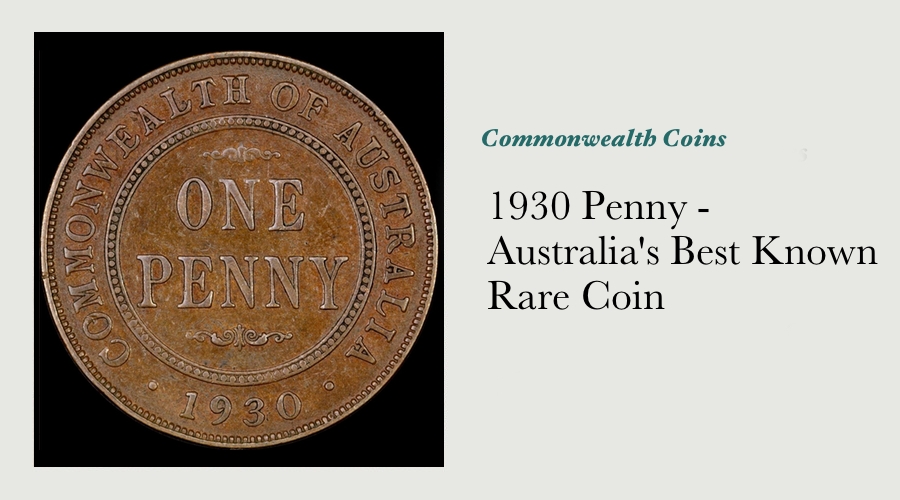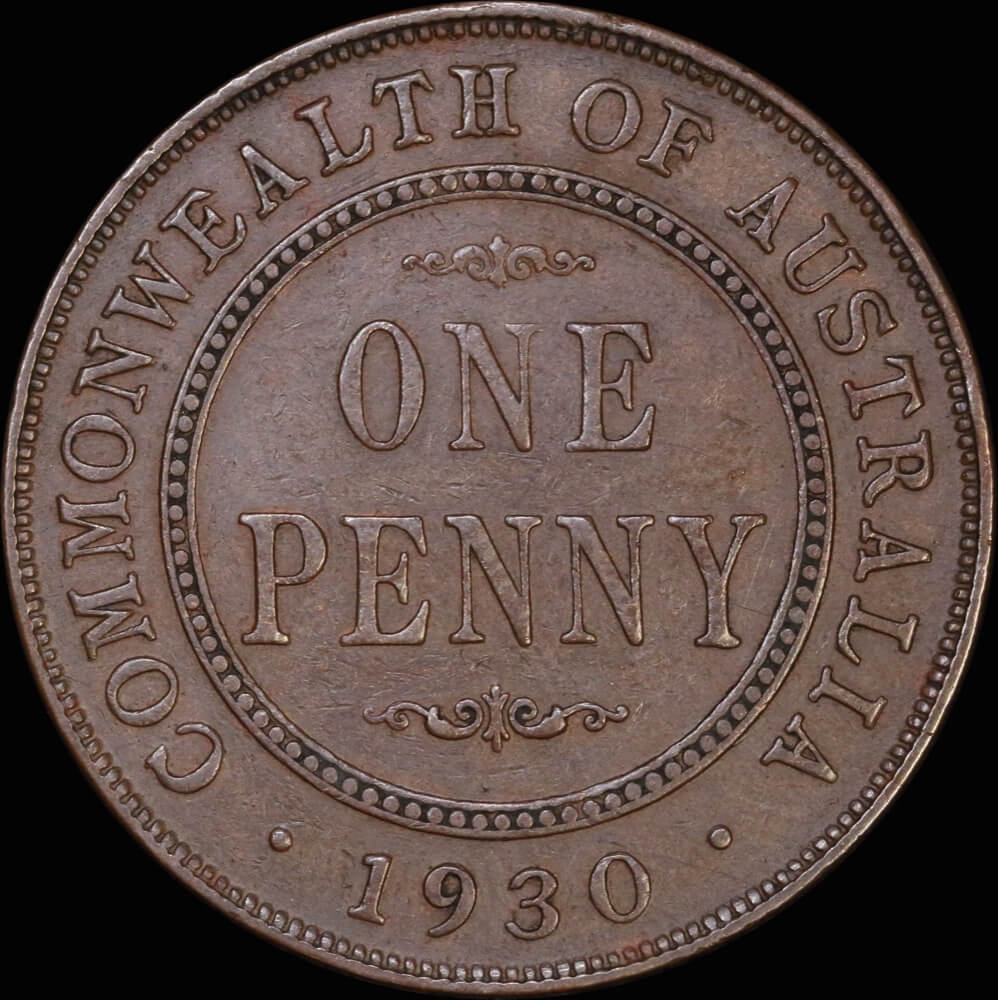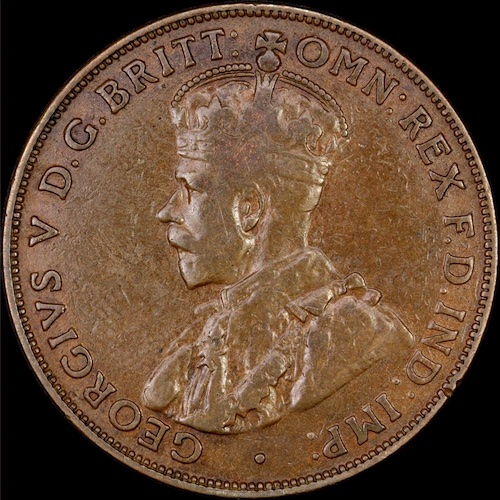1930 Penny - Australia's Best Known Rare Coin

The 1930 penny is, without doubt, the one rare coin that most Australians know about - it started off as being the last coin to go into the Dansco press-in albums that were hugely popular in those days (in fact they're so rare hardly anyone ended up with a complete penny set), and it now rates as an heirloom and an investment.
Unlike paper notes or even the larger silver coins, pennies could be accumulated fairly easily without placing too big a dent in the family budget. It wasn’t a trifling or incidental coin - back in the 1960s a penny could actually buy something, and a collection of 95 coins represented a reasonable spending sacrifice. As they were used every day of the week, most people had the opportunity to check their change each day, and put the ones they didn’t have in their album.
Just the Right Degree of Rarity

Australia 1930 Penny
Image Source: Sterling & Currency
Many collectors soon realised that there were a few gaps in their album which were taking a little longer to fill than others. Some of the old-style King George coins were tough, as was 1946, but even these could be got with persistence.
The really tough one was 1930. It wasn’t long before there were thousands of collectors across the country whom from direct experience knew that the 1930 penny was a rare coin - many of these would have given their eye teeth for the opportunity to get one. In fact, it can also partly be credited with starting the boom in coin investment - frustrated collectors often got to the point where they were willing to actually pay for one, just so they could finish their set!
That there was even a remote possibility it could simply be plucked out of change made it even more appealing. It came to be seen by the average Aussie battler as one of those rare opportunities to financial freedom that had more to do with luck than hard work, in much the same light as a winning lottery ticket. Even today, people still turn out old cupboards & biscuit tins in the hope of finding a fortune!
Why the Mystery?
Just why is there so much mystery surrounding this coin? Surviving Mint records are thin on the ground and those that are available are somewhat patchy in their coverage of the year’s events. One of the more considered opinions on the mintage of the 1930 penny comes from Mr John Sharples, Numismatic Curator at the Museum of Victoria. In his “interim report” to the NAA, he states: “... the place to look for penny production would seem to be shortly after August 13th. Probably a pair of dies were set and brought up to pressure and then permitted to run under normal working conditions for a time as a test. A second small run might then be sought in September to test one of the new obverse dies issued from the workshop on August 29th. Finally, at the end of the year, specimen (or proof) coins were struck for the Melbourne, Adelaide and British Museum collections. “... it would appear that after the two short test runs in August / September .... they were put into storage in anticipation for an order.” [i] In any event, any mintage figures that are discussed in numismatic circles today have been deduced principally from second-hand information.
Detecting a Forgery – A Quick Reference Guide
The 1930 penny is easily Australia’s most forged 20th-century coin. Amateur and professional counterfeiters alike have turned their hand at producing this popular Australian icon, and many collectors have been deceived over the years.
Given the potential risk involved, prospective buyers are advised to become aware of the basic points to look for when determining a coin’s authenticity. As with any numismatic issue, there are certain characteristics of the design, strike and wear which are unique to the 1930 penny. Once these are learned and identified, much of the risk related to buying a 1930 penny is reduced. Although these pages contain much more about counterfeit 1930 pennies than a layman would know, it can never be enough to guard completely against counterfeits and forgeries. If you are looking to buy or sell a 1930 penny, ensure you deal with a member of the Australasian Numismatic Dealer’s Association (ANDA), who are experienced dealers bound by a strict Code of Conduct.
Quick Reference Guide to Authenticating a 1930 Penny:
Obverse: Two different obverse dies were used in the production of 1930 pennies, each with unique identifying characteristics. Nearly all known examples were struck with what is known as the “Indian” obverse die, our research indicates that just two 1930 pennies struck with the “London” obverse die have been sighted.
The first step in authenticating a 1930 penny is to determine which obverse die was used to produce it: if a 1930 penny has the “London” obverse, chances are at least 1,500 to 1 that it is a forgery. Independent authentication of any 1930 penny struck with the “London” obverse die should be obtained.
The “Indian” die can be identified by examining how the legend aligns with the outer beading: the final upstroke in the “N” of “OMN” sits neatly in line with an outer rim bead, whereas the same point on coins struck with the “London” die align between the outer rim beads. The colon following “IMP” is consequently aligned between two beads, rather than in line with one as on the “London” die.
Reverse: Only one reverse die has been observed for this coin, that struck from the “London” master die. The letters in the word “AL” in “AUSTRALIA” are aligned in line with the beads of the outer rim, and the letters “IA” in “AUSTRALIA” are between the beads of the outer rim.
1930 pennies are often forged most obviously through the alteration of the date. The zero in the date of a genuine 1930 penny will exhibit a fat and wide “0”, while most forgeries tend to show a more elongated and narrow “0”. Any visible evidence of tampering with the coin, such as a slight difference in surface colour or any scratch, dent or mark around the date should give cause for caution.
Sterling & Currency is able to provide a written, unconditional, life-time guarantee regarding the authenticity of every item we sell.
Quick Reference Grading Guide – A Superior Example

Australia 1930 Penny - Heads Side
Image Source: Sterling & Currency
The depression saw children going to school without shoes; bread & dripping sandwiches becoming a regular part of the daily diet, and even a penny made a difference to the family budget. Any spare coins lying about the house would surely have been put to good use, and it’s logical to assume that of the entire mintage of 1930 pennies, the vast majority (if not all of it) would have been put to use as legal tender.
There would have been little reason for anyone to check their change until at least the 1950s when coin collecting became something closer to a mainstream activity. Once in circulation then, 1930 pennies would have remained in use for many, many years.
It should be of little surprise then that most of the 1930 pennies that remain in existence today are in a reasonably worn state - grading between Very Good and Good-Fine. An analysis of how King George V pennies in general (and this coin in particular) wear over time will give us a clear idea of what to look for in a superior quality coin.
Important Note:
A numismatist can only determine an accurate grade of a coin by taking all aspects of its condition into account. Characteristics such as strike; wear; lustre and surface quality are all considered. It is impossible to accurately grade a coin by looking at just one section of the design, no matter how important that section is. Having said that, all things being equal, the following comments can be taken as a quick reference guide that will allow a novice to arrive at an approximate grade of any coin they encounter.
Obverse: As with all King George V copper, the band across the base of the King’s crown is the highest point on this side of the coin. By and large, the degree to which detail remains in this band determines the overall grade of the coin. The more detail in the centre of the band, generally speaking, the higher the grade of the coin.
Reverse: This side has a much flatter design than that on the obverse, and accordingly it is somewhat more difficult to grade the coin from examining this side alone. Wear on the reverse of King George V copper tends to be spread evenly across the rim, the lettering in the legend and the inner circle of the design.
As can be seen from the accompanying graph, the rarity of the 1930 penny increases dramatically when quality is a consideration: any example that grades better than about Very Fine may be regarded as being in superior quality. Although this coin is quite rare whatever form it takes, collectors looking to get one in “better than average nick” will do well to examine any potential purchase closely for the extent of detail in the band of King George’s crown. A superior coin will clearly show a good extent of detail in the centre diamond.
Sterling & Currency is able to provide a written, unconditional, life-time guarantee regarding the quality of every item we sell.
| Grade | Description |
| Very Good | Devoid of significant problems, but heavily worn |
| About Fine | Band across base of crown nearly complete |
| Fine | Full band across base of crown |
| Good Fine | Part of the centre diamond remains visible |
| About Very Fine | Most of the centre diamond remains visible |
| Very Fine | The centre diamond remains completely intact |
| Good Very Fine | 7th & 8th pearls in crown are partially visible |
| About Extremely Fine | Majority of detail in the 7th & 8th pearls visible |
| Extremely Fine | Each of the 8 pearls is clearly visible across the base of the king’s crown |
How to Find the Value of 1930 Penny
Confirming that a particular coin is authentic and of a particular grade are the first two steps to determining in the market value, the next is to see what the coin is bringing in the market in that grade.
All many collectors do to determine the market value of a coin or note is to look it up in one of the very popular price guides to coins & banknotes published by either Greg McDonald or Renniks. These books are an excellent introduction to the market, but don’t think they are the bibles of the numismatic world! Buyers will only ever pay what they think an item is worth, regardless of any figure that’s been printed in a book. Similarly, sellers will only accept what they think their item is worth, no matter what figure appears in print. Some buyers may want a particular item desperately; others may only have a mild interest in it. Some sellers may need to raise funds urgently, while others can have all the time in the world.
With such a wide range of players in the market, it should be hardly surprising that two coins in very similar condition can trade for two very different prices. A motivated seller dealing with an indifferent buyer may choose to sell at a relatively low price, while an extremely keen collector dealing with a resolute seller may choose to pay a relatively high price.
A buyer or seller unfamiliar with the market will do well to answer the following questions:
What have comparable coins sold for via auction in recent months?
Are any dealers offering similar coins at the moment, and if so, what price are they being offered at?
How long have these items been on the market? When was the last time they were available?
Although it can be difficult to obtain verifiable transaction data from dealers (simply because this information is not published), auction sales data is one source of information that can be checked to determine where the market is. It is a relatively easy process to obtain a range of auction catalogues via the internet, and to then check the prices realized for those auctions to see what the actual results were.
Frequently Asked Questions:
One question that many novice collectors want to know about Australia's 1930 penny is, why is it so popular? Click this link to read our article that explains just why it has remained popular ever since it was first dicovered between 1940 and 1944.
One of the great mysteries about the 1930 penny is the real reason why it is so rare. Click this link to read our article that explains why so few of them were made during the darkest days of the Great Depression.
Many collectors know that a quick way of determining whether a 1930 penny is genuine or not is to check the obverse (heads side) and see if it is the English or London obverse type. The trouble is, there are 3 genuine 1930 pennies with the English obverse known to exist. Click this link to read our article and learn why this incredibly rare variety was struck, and how to identify them.